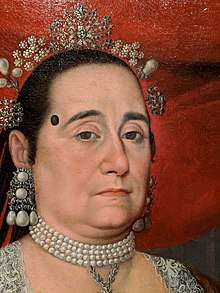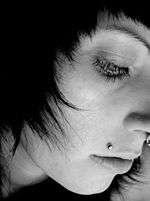Beauty mark
A beauty mark or beauty spot is a euphemism for a type of dark facial mole, so named because such birthmarks are sometimes considered an attractive feature.[1] Medically, such "beauty marks" are generally melanocytic nevus, more specifically the compound variant. Moles of this type may also be located elsewhere on the body, and may also be considered beauty marks if located on the face, shoulder, neck or breast. Artificial beauty marks have been fashionable in some periods.

Artificial beauty mark

Artificial beauty marks became fashionable in sixteenth-century France, and the fashion persisted into the eighteenth century, applied to the face as a form of make-up. They were often in fanciful shapes such as hearts or stars. Besides their decorative value, they could hide smallpox scars or syphilis sores.[2] They could be purchased as silk or velvet patches known as "mouches" (flies). Alexander Pope's 1712 poem The Rape of the Lock mentions such patches as indicators of "secular love":[3]
Here Files of Pins extend their shining Rows,
Puffs, Powders, Patches, Bibles, Billet-doux.
Now awful Beauty puts on all its Arms;
The Fair each moment rises in her Charms,
Repairs her Smiles, awakens ev'ry Grace,
And calls forth all the Wonders of her Face;[4]
The fashion spread to Spain and the Spanish Empire in the eighteenth century, under the name chiqueador.[2]
Natural beauty marks are also often enhanced with color from an eyebrow pencil or pen.[5]
The Monroe piercing has gained popularity in recent years as a flexible way of approximating a beauty mark.
People with notable beauty marks
Many female sex symbols, actresses, and other celebrities are known for their beauty marks:[5][6][7]
|
|

A few male actors are also known for their beauty marks:[5]
- George Hamilton, born 1939
In fiction
In the conclusion of the book The Silence of the Lambs, the heroine Clarice Starling gains an artificial beauty mark when burnt gunpowder gets lodged in the flesh of her cheek. She retains this mark in the sequel novel Hannibal. This symbolism (along with Dr. Lecter's polydactylism) did not get carried over into the film.
Joan Crawford had a prominent beauty mark in her role as Sadie Thompson in Rain.
See also
- Bindi (decoration)
- Birthmark
- Freckles
- Melanocytic nevus
- Monroe piercing
References
- Ariel, Irving M. (1981). A Historical Introduction: Is the beauty mark a mark of beauty or a potentially dangerous cancer? Malignant Melanoma, Appleton-Century-Crofts, ISBN 978-0-8385-6114-0
- "Beauty Marks Go Global", ARTicle, blog of the Art Institute of Chicago, January 14, 2015
- "Pope: Rape of the Lock". University of St Andrews. 16 March 1999. Retrieved 1 December 2013.
- Pope, Alexander (May 1712). "The Rape of the Lock: An Heroi-Comical Poem". Canto 1. Retrieved 1 December 2013.
- Barbara Cloud, "Marks of Distinction", Chicago Tribute, April 25, 1990
- Schulte-Hillen, Sophie (August 14, 2017). "The 9 Greatest Beauty Marks of All Time, from Cindy Crawford to Madonna". Vogue.
- White, Jackie (April 30, 1995). Behind the glamour lurks an ugly, dirty business. Kansas City Star